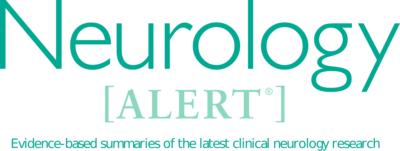
Neurology Alert – October 1, 2021
October 1, 2021
View Issues
-
Surgical Approaches to Decompression in Degenerative Lumbar Spondylolisthesis
A multicenter, randomized, noninferiority trial of people with symptomatic lumbar stenosis and single-level spondylolisthesis who were refractory to conservative treatment found no significant difference between outcomes in those who underwent decompression surgery with instrumented fusion vs. decompression surgery without fusion.
-
Diagnostic Utility of CSF Alpha-Synuclein
This observational study investigated whether the cerebrospinal fluid (CSF) α-synuclein (α-syn) real-time quaking-induced conversion (RT-QuIC) assay, applied to 289 CSF samples, accurately identified patients with mild cognitive impairment (MCI) caused by probable Lewy body (LB) disease. RT-QuIC identified patients with MCI-LB against cognitively unimpaired controls with 95% sensitivity, 97% specificity, and 96% accuracy and showed 98% specificity in neuropathologic controls, indicating that CSF α-syn RT-QuIC is a robust biomarker for prodromal dementia with Lewy bodies.
-
Autologous Hematopoietic Stem Cell Transplantation in Multiple Sclerosis
This retrospective study of autologous hematopoietic stem cell transplantation in patients with active relapsing remitting multiple sclerosis or progressive multiple sclerosis showed efficacy in relapse rate reduction and on magnetic resonance imaging and disability outcomes during a median post-transplant follow-up of about two years. There were risks, including death, associated with the treatment.
-
Pregnancy-Associated Stroke Is Increasing in Frequency
Stroke during pregnancy or the puerperium is a rare event but accounts for a considerable part of maternal morbidity and mortality. The incidence has been increasing in all countries, particularly in wealthy industrialized countries, where pregnancy is being delayed considerably and other cardiovascular risk factors have taken on greater importance.
-
Intensive Lowering of Blood Pressure Does Not Affect the Progression of Small Vessel Disease
Small vessel disease of the brain accounts for 20% to 25% of all ischemic strokes and is a common cause of vascular cognitive impairments. The major risk factor for small vessel disease is hypertension. Targeting a systolic blood pressure of 120 mmHg to 125 mmHg has been recommended, but this has not been confirmed as effective in preventing stroke or long-term cognitive impairment in these patients.
-
Telestroke Consultation Increases Rate of Thrombolysis and Reduces Mortality
Real-time video conferencing between the patient, a remotely located stroke specialist, and the bedside healthcare provider in a hospital emergency department is referred to as “telestroke.” However, there are little data comparing its benefit with in-person evaluation and treatment for hospitals that do not have in-hospital stroke specialists 24 hours per day, seven days per week.
-
Basilar Artery Occlusion: Endovascular Thrombectomy and Medical Therapy Have Similar Outcomes
Basilar artery occlusion is a rare form of ischemic stroke and accounts for about 10% of large vessel occlusions reported in the literature. These investigators conducted a randomized trial, enrolling patients from 2011 through 2019, even though multiple studies published in 2015 demonstrated benefit of endovascular therapy in anterior circulation large vessel occlusions. Efficacy and safety were compared with medical therapy in patients who underwent endovascular therapy within six hours after the estimated time of onset of symptoms.
-
Clinical and Perfusion Mismatch Criteria Both Are Reliable in Identifying Patients Who Will Benefit from Endovascular Therapy
Since 2015, when multiple clinical trials were published showing the efficacy of endovascular thrombectomy (EVT) for large vessel occlusion within six hours of stroke onset, additional criteria have been developed to identify those patients who will benefit from EVT beyond six hours. The AURORA investigators collected patient data from six large clinical trials and performed a meta-analysis to determine if a clinical mismatch or an imaging mismatch protocol was better at predicting good outcomes in patients treated between six hours and 24 hours after the onset of clinical stroke symptoms.
-
In Young Adults, Marijuana Use Is Not Associated with Increased Risk of Early Onset Ischemic Stroke
Marijuana use, both recreational and medical, is increasing among young adults, and many states are legalizing its use. A variety of cardiovascular effects have been described, which could increase the risk of cardiovascular complications, including stroke, and some observational studies have suggested an increased stroke risk from marijuana use. But there are few epidemiological studies that have evaluated this association.
